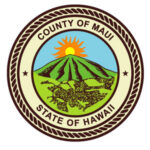Maui Economic Development Board’s (MEDB) Women in Technology (WIT) Project presented a workshop for K-12 teachers on Exploring the Watershed through STEM (science, technology, engineering, mathematics) Education. Featuring WIT’s STEMworks™ Watershed Curriculum, the event focused on how GIS (Geographic Information System) Story Mapping can be utilized to protect and maintain the health of our island watersheds.
“The purpose of the workshop is to expose teachers to the power of using Story Maps to present spatial or geographic data in elementary, intermediate, and high school classrooms,” said Emily Haines-Swatek, workshop presenter and King Kekaulike High School STEMworks™ Facilitator. “Using ArcGIS Online, the teachers learned how to combine authoritative maps with narrative text and images that tell an integrated multimedia story.”
Shea Rodriguez, St. Anthony Middle School math teacher, said, “GIS mapping gives my students the chance to develop a variety of skills, and share cross-content knowledge in a hands-on technology approach. One of the most significant techniques offered in the workshop is to enable the students to do their own research. They will learn to gather and apply data to create valuable products that can be used in the community beyond the classroom. WIT’s STEMworks™ program also provides the chance for students to collaborate while they learn about Hawai’ian culture.”
WIT Team Member Denissa Andrade noted, “WIT is committed to supporting educators with essential STEM training and resources necessary for successful student engagement. Thanks to the funding MEDB received from the National Oceanic and Atmospheric Administration (NOAA), students are learning the importance of protecting Hawai’i’s watersheds and they are becoming stewards of our islands.”
With the NOAA funding, WIT also supports student experimental field trips to local watersheds such as Kealia Pond, a 704-acre bird sanctuary on Maui’s south coast. Led by biologists, naturalists, and other industry professionals, students observed Hawaii’s endangered wetland birds and migratory visitors firsthand. Using technology such as GPS and mobile devices, students were tasked with creating Story Maps to promote watershed awareness in the community.
Teachers learned how to introduce their students to the power of GIS Story Mapping with free online mapping tools to explore and analyze data.
Denissa Andrade, MEDB WIT Team Member

